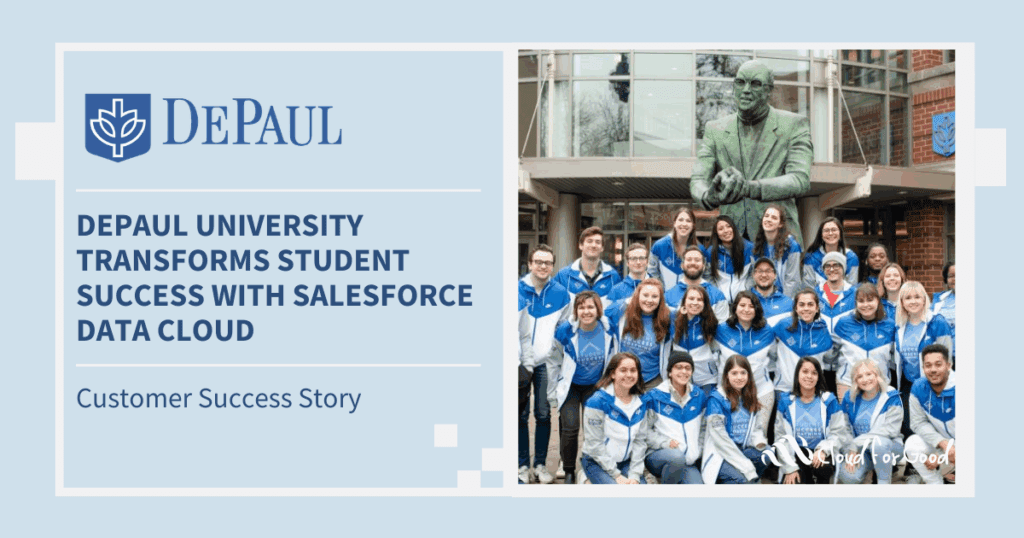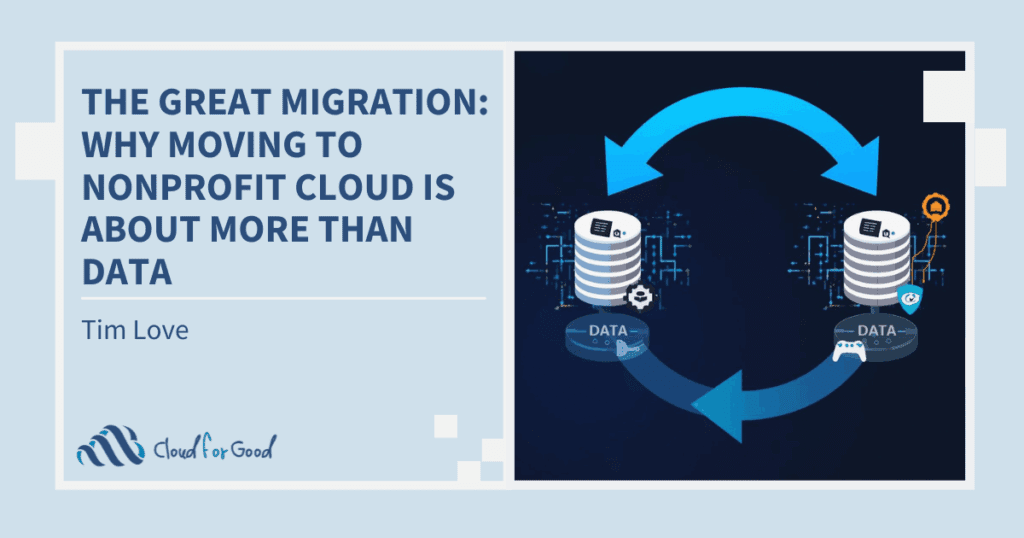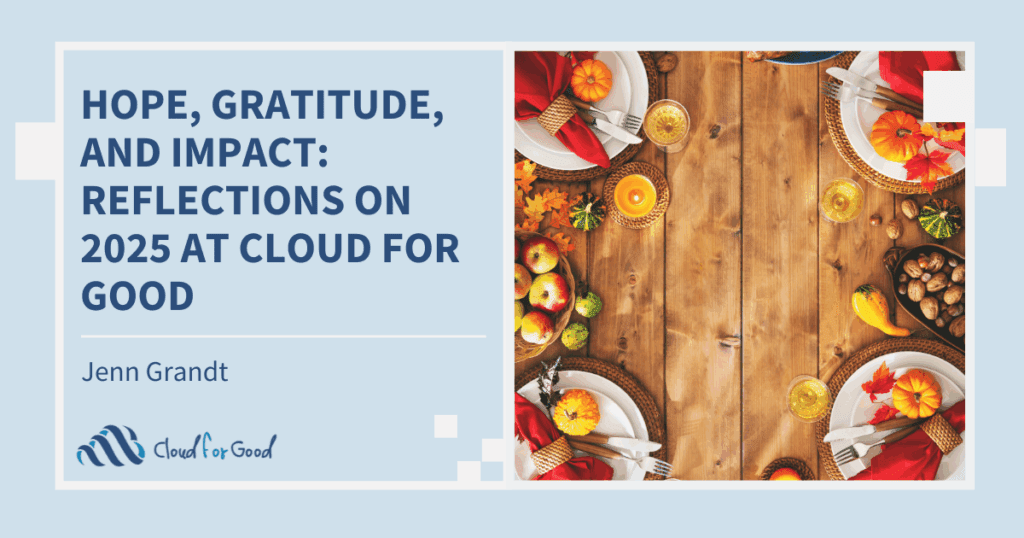In a time when nonprofits are being asked to do more with less, technology is no longer a luxury—it’s a lifeline. With so much uncertainty around funding streams, many organizations are asking how they can stay relevant and how they can keep serving their communities even when budgets are getting increasingly tighter. What is also particularly challenging right now is that while federal dollars and traditional funding sources are shrinking, the needs in our communities are not decreasing—they are growing. Yet, as resources become more constrained, many nonprofits are being asked to serve more people and address more complex problems, all while operating with tighter budgets.
I had the opportunity to chat with Linda Davis, Enterprise Account Executive, NPO at Salesforce, on how mission-driven organizations can leverage smart, scalable technology to deepen impact, drive efficiency, and future-proof their missions. Here are the highlights of our conversation and key takeaways for nonprofit leaders on how technology can power their organizations through uncertainty.
How to Stay Resilient With Technology
Craig Mabee (CM): Linda, when you think about what you are hearing that resources are becoming more unpredictable, where do you see technology stepping in to help nonprofits stay resilient?
Linda Davis (LD): That’s a great question. I think when resources are tied, technology becomes a game changer for nonprofits to try to stay resilient. Technology should be the heart of everything that they do to meet the evolving needs of their community.
First, leverage digital tools to help make data-driven decisions. That way, nonprofits can use their limited resources more wisely. CRM systems and analytic platforms make it easier to spot those trends and opportunities, even in the uncertain times that a lot of our nonprofits are facing today.
I think it also helps to diversify revenue streams either by online fundraising, peer-to-peer campaigns, or recurring donations. It really allows nonprofits to reach more people but also be able to raise more funds outside of traditional events.
And of course, we also know that a lot of organizations have people back in the office or are in a hybrid mode. Remote collaboration tools have become essential now, keeping teams and volunteers connected and productive no matter where they are or their different circumstances. It’s something that we saw especially during the pandemic.
Lastly, [technology] is going to be in automation and AI. AI has been a big topic for a long time. AI, we know, is here to stay, It’s not going anywhere. It helps you ease those administrative staffs by letting staff focus on what matters the most, which is serving your community. It’s automating those emails or streamlining those reports, but I think these tools help you maximize impact, but also within a small team, which most nonprofits face.
In short, technology doesn’t just help nonprofits survive these tough times. I really believe that pain turns into gain, and it gives them the flexibility to adapt, innovate, but also keep pushing forward with their missions.
How Salesforce Helps Improve Efficiency Without Adding More Work
CM: We often talk about doing more with less. How do you see Salesforce products helping nonprofits improve efficiency without adding to the staff burden? It wouldn’t be the first time we heard nonprofits say, “Which hat am I wearing today, because I wear many hats.” So how do we see Salesforce helping out in this space?
LD: This is a common conversation that we hear from nonprofits. When you talk about Salesforce, Salesforce is not just a point solution—it’s the foundation as a platform. Salesforce is built with efficiency and scalability in mind.
Key priorities for nonprofit systems, like you said, are working with limited resources and staff wearing multiple hats.
So, how do we help nonprofits centralize that data and automate those everyday tasks to help reduce annual work or free up staff’s time so they can focus on what really matters the most? When it comes to Salesforce, we have different flavors of Salesforce that serve different types of customers, and Nonprofit Cloud is one of them. It’s built for a nonprofit community. When it comes to managing fundraising programs, relationship all-in-one. Once you start centralizing that data, you really get to know your community, you’re eliminating multiple systems, cutting down data entries, and making daily operations smoother and less time-consuming to allow you to tell your community a more impactful story.
Some examples I can give you here are AI-powered agents for automations. AI agents can answer program inquiries, eligibility questions, applications, freeing up staff from repetitive tasks either by having a virtual help desk to handle common support requests from volunteers, donors, constituents, or members, and making sure they are escalating those conflict issues to staff.
Automation is the key one here. It helps you simplify application processes, filling out forms, tracking deadlines, and sending reminders. You’d be surprised that many of these nonprofits are doing these manually today.
The next is campaign automation. You can manage donor communication, welcome emails, and impact reports without requiring manual follow ups. It definitely helps free up more time, but also give you real-time dashboard reports so that, as a nonprofit leader, you have those instant insights and performance. That way, you know how to move forward and know how to serve your community.
Salesforce Apps and Features to Fill Funding Gaps and Drive Revenue
CM: As we move on here, talking about Salesforce and such, are there any features or apps you’ve seen nonprofits use creatively to fill funding gaps or drive alternative revenue?
LD: Yes! Many nonprofits are using Salesforce in creative ways to fill those funding gaps and diversify revenue:
- P2P Fundraising: One is peer-to-peer (P2P) fundraisers leveraging something like Experience Cloud to let supporters create personal fundraising pages and expand donor reach-outs with minimal staff effort.
- AI Insights: Another one is AI insights. In corporate sponsorships, for example, AI can find promising corporate partners based on supporter data and connections.
- Program Optimizations: Making sure that you’re identifying those high-performing fee-based programs with scalable revenue.
- Matching Gifts: With tools like 360MatchPro, you can spot eligible donors for corporate gift matching, which is often untapped revenue.
- Integrated Strategy: Have a platform that allows you to integrate and give you flexibility to use Salesforce to manage programs or maybe promote leveraging something like Marketing Cloud or Account Engagement. That way, you’re tracking those outcomes literally all on a unified platform.
But I think the real creativity here lies in combining these tools together. That way, you’re leveraging Salesforce to its fullest, making sure that you’re tracking those engagements, and you have that holistic view of your community.
Mobile Functionality Support For Major Gifts and Planned Giving
CM: You know, Linda, something you said earlier was about being more mobile. That’s something that Salesforce—and a feature of Salesforce—that allows major gift officers and planned giving officers an opportunity to be more mobile, to be out in the field, to be out in the community, engaging where the donors are, especially major gift and planned giving donors. Do you have any experience with that, using mobile features and functionality?
LD: The Salesforce Mobile app gives you access to your data. It gives you access to your book of business. It gives you access to your donor data. So that way, you can basically make sure that, if you’re working from anywhere, you have access, are adding notes, or maybe collaborating with your team members, literally from your tablet or from your mobile phone. And all of that, of course, syncs directly into Salesforce so that you don’t miss out on any opportunities.
CM: I think that’s great, especially when you think back to working with like a major donor and you’re out in community. If you’re managing your entire missions, you’ve got not just your donors, but you’re running programs on Salesforce. You can have a report or a dashboard that can really show your donors not only how your organization is making an impact, but also how their donation and their support is helping you drive impact for your mission.
Technology Investment Priorities: Efficiency and Long-Term Scalability
CM: For technology leaders that might be on the call, or nonprofits, you know, are all being tasked with solving more problems with fewer dollars today, for sure, I don’t think it really goes away. What advice would you give when it comes to prioritizing technology investments?
LD: I would say for a nonprofit technology leader facing the challenge of solving more dollars, I think the key focus is investment that delivers both immediate efficiency and long-term scalability.
How to prioritize it is to start with your mission. Make sure that you’ve anchored every tech investment to your organization’s core values and core goals. Ask if this tool helps serve more people, feed more people, or raise more funds? Is it telling your story more effectively? And if it doesn’t tie clearly to impact, it’s like a distraction.
Second is looking for the tools that can solve that—choosing a platform that handles multiple needs, like a CRM, marketing, fundraising, program management, within one ecosystem. This definitely reduces integration headaches.
Next is to automate those repetitive tasks—prioritizing those tools that reduce manual work—even those small automations like syncing donor data, scheduling reports, sending reminders, the basic stuff.
Also, build for the future and lean on your community. Nonprofits need to start doing that today. Take advantage of the nonprofit tech community, user groups, and Salesforce Trailblazer user groups. There’s plenty of those that our customers can get involved with. There’s partner networks and, of course, we also offer pro bono resources. Organizations that are likely to face the same challenges as yours can offer guidance and even share solutions as we move forward.
In short, choose technology that multiplies your team’s capacity but not your to-do list. The best investment is the one that enables your people to really focus on what matters, and it’s delivering your mission.
CM: I think that’s amazing, and I really loved your comment about if it doesn’t connect, or directly connect, with your mission, then it’s a distraction. I can’t tell you how many times when I worked for or with nonprofit organizations and it’s like, “Oh, there’s this funding opportunity. Well, let’s do that” and we create a new line of business, or something like that, because the funding is available. But in these times, part of it is making sure that it directly connects to your mission. That’s where the priority needs to be.
Fostering a Culture That Embraces Technology With Change Management
CM: Technology is only part of it. We know technology is only as good as the data, and it’s only as good as the people using it and how they’re trained. How can nonprofit leaders foster a culture that embraces technology as a tool for sustainability, for relevance, and not just for straight operations?
LD: Craig, you’re absolutely right. When I talk to nonprofits, it’s not the technology alone. It’s the people. It’s making sure you’re changing the culture in a way to adapt to the technology. Some people just think of it as a tool. But what really makes the difference is in the mindset culture of the people using it. For nonprofit leaders, that means fostering a culture where technology isn’t seen as an “extra” just for operations, but a strategic enabler of the mission.
A few ways to build that kind of culture is to start with the “why”. Tie every tech investment back to mission we talked about. Show your team how a new system can help them serve more people or save more time. Go back to tell an impactful story. I think staff understand their purpose. We know that when it comes to nonprofit staff, they do their work for a reason. It’s to meet the needs of their community. And I think next is to make it collaborative, not top-down. Involve staff from different teams in the planning and the decision-making process. The best tech solutions aren’t really built by the people who actually use them. Their insights lead to better adoption and then also better results.
Next is to invest into learning, not just the tools. Too often, nonprofits stretch by buying a platform but skipping the training, or maybe buying a point solution because it’s the easy way out. Prioritize those ongoing learning and capacity-building so that your team feels confident, supported, and also empowered.
The next is celebrate those wins—either big or small. Automating those processes is going to save someone five hours or ten hours a week. Get a dashboard. Help secure a grant. Share those stories so that people see their real impact in their own world.
And last is going to be [taking] leadership. Walk the talk. Make sure you’re also using the system right by leveraging dashboards and prioritizing those digital strategies. But also make sure that you’re making smart decisions as you move forward.
Building Resilience for Tomorrow
CM: Let’s leave folks with something that they can do to make a difference today. What’s one small step a nonprofit could take today to start building more resilience for tomorrow?
LD: I would say the great, small step that nonprofits can take today is that it just starts with data. Having a good data strategy, centralizing your data—whether it’s going to be donor information, program outcomes, or volunteer hours—having everything in one place makes it easier to make smarter decisions, be able to engage your supporters in a whole new way, and be able to quickly adapt when things change.
Also, the right system doesn’t have to be complex. It can start with something simple like as a CRM tool. Salesforce offers ten free licenses for nonprofits; you can start there. Be able to organize and track key information. Also, leverage your network as well too. It takes a village to do this work, and you should definitely leverage your network and people who are already in the game or might be doing it right. Lean on those folks and get their support because it does takes a village to do this work and you all can survive together.
CM: I think it does take it does take a village. The one thing that I’ve always admired about the nonprofit space, the nonprofit community, is that they’re always willing to share and help make an impact. So the one thing that I would leave behind is you don’t have to do it all by yourself—to do it on your own. There are peer organizations. Whether there’s peer organizations in your community or your region, or if you have a national office, check and see if they’re already working on something. Maybe they’re working on something with a tech partner. See if you can join, if you can contribute, participate, and learn. You don’t always have to be first. You don’t need to own everything, but you definitely [need] a space to share and participate in. My takeaway would be you don’t always have to build something on your own.
LD: Yes, don’t try to reinvent the wheel. It’s already created.
CM: Exactly. You’re not reinventing the wheel. Fortune 500 companies are influencing the overall Salesforce platform, and the nonprofit community is definitely influencing Nonprofit Cloud and the functionality that Salesforce is bringing to nonprofit organizations.
So it does take more than a village. It takes the entire community.
LD: There you go. And the power of our ecosystem—the AppExchange—is definitely a place where you can check out and see what our partners are doing across the world. It is huge as well.
Closing Thoughts
My conversation with Linda really showed that while funding challenges are real, they don’t have to define the future of our organizations. Nonprofits have always been incredibly resourceful, and with the right technology, we can turn obstacles into opportunities. Whether it’s finding new ways to connect with supporters, streamlining operations, or proving impact with better data, platforms like Salesforce are giving nonprofits the tools to not just weather the storm, but to grow stronger through it.
At the end of the day, it’s also not just about technology—it’s about what that technology that makes possible: more lives touched, more stories told, and more missions fulfilled.
That’s something worth investing in, even in uncertain times.





